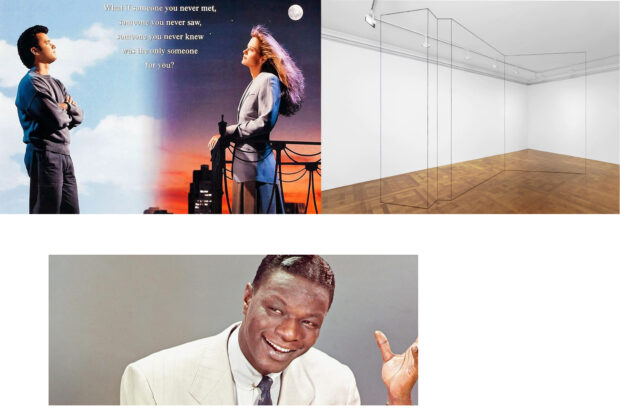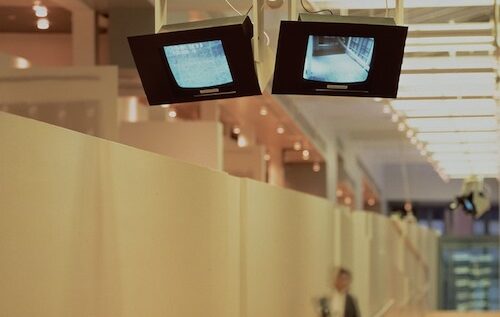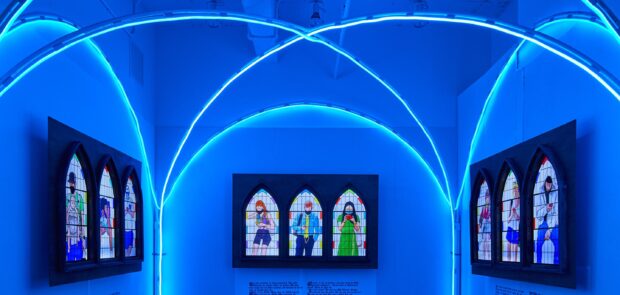
To my eye, the one often reproduced photograph of Robert Smithson’s The Eliminator (1964) makes it a rather awkward and curious object, its title unnecessarily macabre. If only Smithson had been a contemporary of André Breton’s, I could have easily imagined the piece in one of the impromptu Surrealist shows. Much of that mystique is gone, now that I’ve finally seen it in person (it’s up at the New Museum in Ghosts in the Machine until September 30th), and I can certainly blame the black-and-white illustration for its unflattering shortcomings.
An early work consisting of encased mirrors and neon tubes, The Eliminator is tied to Smithson’s semi-scientific interests in vision and perception, matter and structure, time and George Kubler. According to Eugenie Tsai, The Eliminator, along with other sculptural works from the same period such as the Enantiomorphic Chambers (from 1965, another illustration of Smithson’s taste for scientific eccentricities), “continued to explore in a more literal fashion the theme of blindness found in Smithson’s early religious paintings.”[1]
While consistent with this past, the installation can be read as a reference to the future, as an understated statement piece—unique in the artist’s repertoire of themes, yet central to his refinement of a central project where perception, vision and memory interweave. Below is Smithson’s short essay, “The Eliminator” (1964)[2]:
“The Eliminator overloads the eye whenever the red neon flashes on, and in so doing diminishes the viewer’s memory dependencies or traces. Memory vanishes, while looking at the Eliminator. The viewer doesn’t know what he is looking at, because he has no surface space to fixate on; thus he becomes aware of the emptiness of his own sight or sees through his sight. Light, mirror reflection, and shadow fabricate the perceptual intake of the eyes. Unreality becomes actual and solid.
The Eliminator is a clock that doesn’t keep time, but loses it. The intervals between the flashes of neon are ‘void intervals’ or what George Kubler calls, ‘the rupture between past and future.’ The Eliminator orders negative time as it avoids historical space.”
***
Art historians sometimes pride themselves on leaps of faith taken between historical periods, associations they often refer to as “speculative.” Many of these end up in footnotes, fallen for the sake of a more scientific, reputable discussion of the subject at hand. Using this blog as an excuse, I propose the following speculation.
A few days after seeing the New Museum show, I watched a group of men unload a truck full of music equipment next door to my house. Sitting on the curb: a beat up pair of EV Eliminator speakers, charged with past and future sound.

According to Jamie Bergen, EV product category manager for speakers, “In the late 1960’s, the original Electro-Voice Eliminator started a revolution among working musicians by providing the first speaker with decent bandwidth that could handle the power demands of modern music.”[3]
–> See plan for Electro-Voice Eliminator Model 1A, 1969 here and here.
If flipped on its side, by sheer formal analogy the historian will notice that the speaker and Smithson’s curious object share more than just a name. The box / sound case—its back soundproof, directed forward, at the subject—once plugged in, will generate waves of absorptive, directional, no-longer-containable sound. Similarly, Smithson’s box / neon case will begin to flicker red-mirrored light, drawing the spectator into its rhythm, pushing her attention from one reflected surface to another, and then back to her eyes, face, and body.
Neither piece is self-sufficient; both are experiential, requiring the presence of a participant to complete the sensorial situation they have been designed to produce. As objects embedded in and consumed by popular culture, the Electro-Voice speakers will undergo numerous such encounters. But their ready availability will limit their future, every instance of use speeding up the disintegration of their parts. The museum, on the other hand, will ensure that the prototype (Smithson’s Eliminator predates the E-V) will survive inadequate storage and overuse, at the expense of such familiar encounters with the viewer.
Two sets of complementary experiences result: 1) sound and movement leading to an increased awareness of the body in space while at the same time to the dissolution of that same body within the created sound environment, 2) concentrated attention will generate a heightened awareness of vision leading to yet another type of disembodied experience—until the historian takes a step back from the situation, tired, victim of a false, entirely made-up coincidence?
As Smithson wrote, “The Eliminator is a clock that doesn’t keep time, but loses it. The intervals between the flashes of neon are ‘void intervals’ or what George Kubler calls, ‘the rupture between past and future.’ The Eliminator orders negative time as it avoids historical space.” The experiment carves at itself: The Eliminator, the 1964 photograph, the 2012 museum exhibit—each inconsistently captures what has become the memory of the piece.
Beyond the “social lives of things,” my own vanishing memory tempts me to reconstruct the past lives of objects: the memories they contain, outside of their existence as art. The attempt here was to create an affective bond between two seductively similar artifacts, objects which, although locked in their contexts, seek to transgress the chronological order of history. Because despite our most committed efforts to preserve, in writing history we accept the corrosive effect of time on memory.
***
Further readings:
Appadurai, Arjun, ed. The Social Lives of Things: Commodities in Cultural Perspective. Cambridge, UK: Cambridge University Press, 1986.
Kubler, George. The Shape of Time: Remarks on the History of Things. New Haven, CT: Yale University Press, 1962.
Flam, Jack, ed. Robert Smithson: The Collected Writings. Berkeley, CA: University of California Press, 1996.
Tsai, Eugenie, and Cornelia Butler. Robert Smithson. Los Angeles, CA: The Museum of Contemporary Art; Berkeley, CA: University of California Press, 2004.
A previous version of this review appeared on the author’s blog.
1. Eugenie Tsai, “Robert Smithson: Plotting a Line from Passaic, New Jersey, to Amarillo, Texas,” in Robert Smithson, Eugenie Tsai et al. (Los Angeles: The Museum of Contemporary Art, and Berkeley: University of California Press, 2004): 19.
2. Robert Smithson, “The Eliminator,” in Robert Smithson: The Collected Writings, ed. Jack Flam (Berkeley: University of California Press, 1996): 327.
3. Quoted in Harmony Central News, July 27, 2000.













This is fantastic, Ileana! What deeply perceptive, sparkling writing. Wow. I love it!
Judy Cuttler
Jan. 21, 2014